I migliori strumenti e accessori per la serigrafia
introduzione:
In questo articolo, Esploreremo il mondo degli strumenti e degli accessori per la stampa dello schermo, essenziale per creare stampe meravigliose su varie superfici. Whether you’;re un principiante o una stampante a schermo esperto, Avere i materiali giusti per la stampa a schermo può fare una differenza significativa nella qualità e nell'efficienza delle tue stampe. Dalle attrezzature necessarie ai materiali di stampa dello schermo, stencil, e tecniche di configurazione, we’;Coprirò tutto ciò che devi sapere per migliorare il tuo percorso di stampa sullo schermo. Preparati a immergerti nel regno delle attrezzature per la stampa dello schermo e scopri gli strumenti che elevranno il tuo mestiere a nuove altezze.
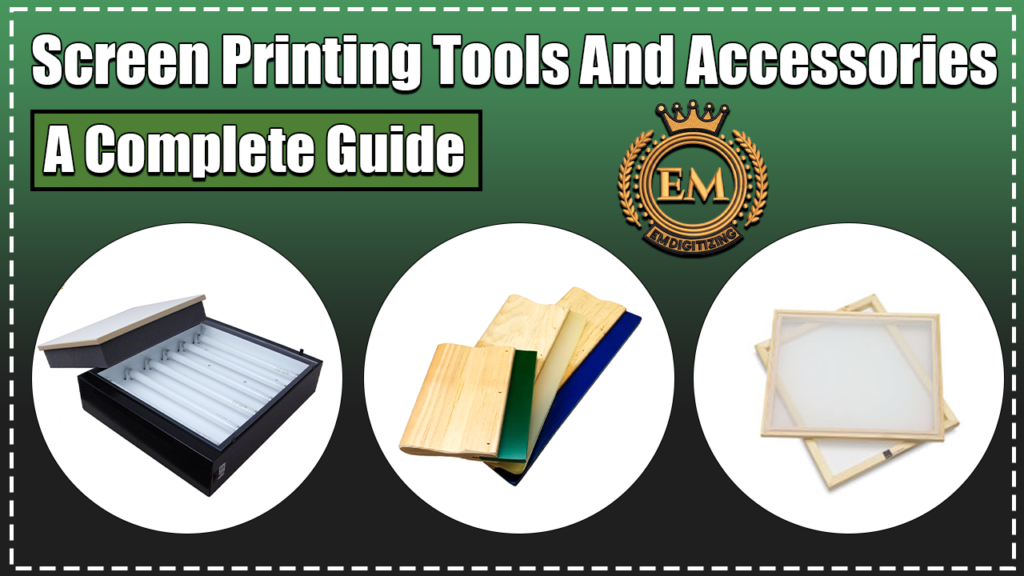
I migliori strumenti e accessori per la serigrafia
Strumenti e accessori per la stampa dello schermo: una guida completa

Serigrafia, noto anche come screening della seta, è un metodo di stampa popolare e versatile che consente di creare vibranti e durevoli disegni da ricamo Su varie superfici. Whether you’;interessato a stampare le magliette, manifesti, o anche opere d'arte, Avere gli strumenti e gli accessori giusti è cruciale per ottenere risultati di qualità professionale. In questo articolo, Amprocheremo nel mondo degli strumenti e degli accessori per la stampa dello schermo, Fornendoti una guida completa per aiutarti a iniziare o migliorare la tua configurazione di stampa schermata esistente.
Attrezzatura da stampa a schermo:
La spina dorsale di qualsiasi operazione di stampa schermata è l'apparecchiatura. I componenti chiave includono:
Schermi:
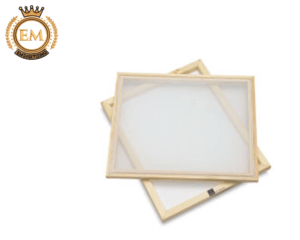
Gli schermi sono i fondamenta della stampa dello schermo. Sono costituiti da una mesh allungata su un telaio. Le aperture di mesh consentono di passare l'inchiostro, creando il disegno desiderato. Gli schermi sono disponibili in vari conteggi di mesh, che determinano il livello di dettaglio e la copertura dell'inchiostro nelle tue stampe.
Spatole:
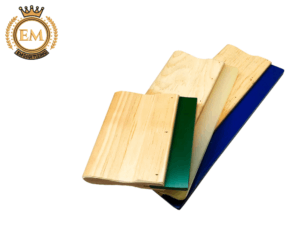
Gli squilli vengono utilizzati per spingere l'inchiostro attraverso lo schermo e sulla superficie di stampa. Sono in genere realizzati in gomma o poliuretano, and their hardness and size can be chosen based on the type of print and ink you’;stai usando.
Macchina da stampa:
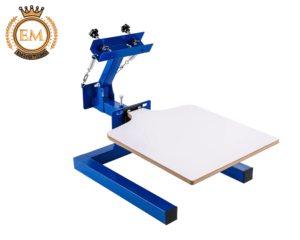
Considera la quantità di copertura di inchiostro richiesta per il tuo progetto. Una copertura eccessiva di inchiostro può causare sbavature, sbavature, o una perdita di dettagli fini. D'altro canto, una copertura insufficiente dell'inchiostro potrebbe provocare una stampa irregolare o irregolare. Trova un equilibrio tra la quantità di inchiostro utilizzata e l'effetto desiderato per ottenere risultati ottimali.
Unità di esposizione:
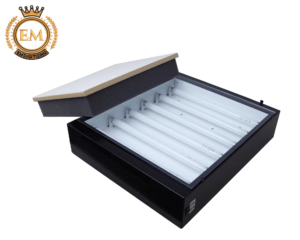
Un'unità di esposizione viene utilizzata per trasferire il design sullo schermo. Espone lo schermo alla luce, che indurisce un rivestimento di emulsione sensibile alla luce. Le aree dello schermo coperte dal design rimangono non esposte e possono essere lavate, Creazione di aperture di stencil per il passaggio dell'inchiostro.
Essiccatore a nastro trasportatore:
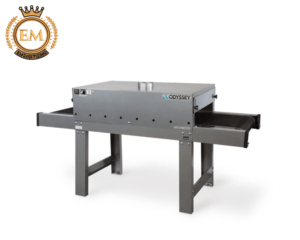
Un asciugatrice trasportatore è essenziale per curare l'inchiostro e renderlo permanente sulla superficie stampata. Usa il calore per asciugare e curare l'inchiostro, Garantire durata e lavabilità.
Unità di esposizione:
Un'unità di esposizione viene utilizzata per trasferire il design sullo schermo esponendolo alla luce. A seconda del budget e delle esigenze, Puoi scegliere tra unità di esposizione al tavolo o più grandi, Modelli indipendenti.
Rack di asciugatura:
Una griglia di asciugatura è essenziale per asciugare gli indumenti o i materiali stampati dopo che sono stati stampati. Consente un flusso d'aria adeguato e impedisce lo smuding di inchiostro o l'adesione.
Sistema di registrazione:
Sistemi di registrazione avanzati, come i sistemi di registrazione di micro-registrazione o pin, offrire un controllo preciso sull'allineamento di più schermi. Questi sistemi sono particolarmente utili per stampe o design multicolori che richiedono un'elevata precisione.
Unità di cura flash:
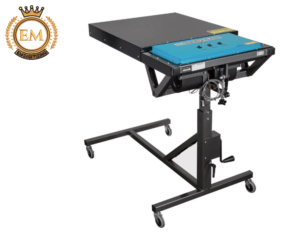
Un'unità di cura flash viene utilizzata per curare parzialmente l'inchiostro tra i colori o su richiesta per prevenire lo smudge e consentire più strati di inchiostro. Fornisce calore controllato per asciugare rapidamente l'inchiostro senza curarlo completamente.
Booth di washout:
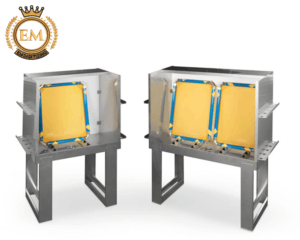
Una cabina di washout viene utilizzata per la pulizia e il recupero degli schermi. In genere presenta un lavandino integrato, spruzzatori d'acqua, e un sistema di filtrazione per prevenire gli scarichi intasati.
Rondella di pressione:
Una rondella di pressione può essere utilizzata in combinazione con una cabina di washout per rimuovere l'inchiostro testardo e l'emulsione dagli schermi. Offre un flusso d'acqua ad alta pressione che pulisce efficacemente lo schermo.
Schermati e carrelli:
Schermate e carrelli offrono un modo conveniente per organizzare e archiviare schermi. Ti permettono di mantenere gli schermi in posizione verticale, prevenire danni e facilitare un facile accesso durante il processo di stampa.
Tabella di stampa sullo schermo:
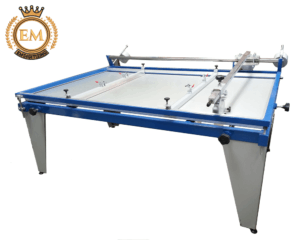
Una tabella di stampa schermata fornisce una superficie stabile e liscia per posizionare i substrati durante la stampa. In genere presenta un sistema di aspirazione o adesivo per mantenere il substrato saldamente in atto.
Pressa di calore:
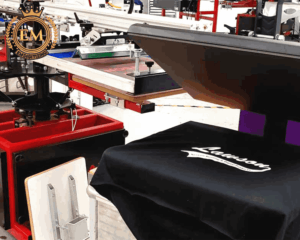
Sebbene non direttamente correlato alla stampa dello schermo, Una stampa di calore può essere un'aggiunta preziosa alla tua configurazione. Viene utilizzato per curare l'inchiostro e legarlo al substrato usando calore e pressione. Le pressioni di calore sono comunemente utilizzate per stampe più piccole o oggetti speciali.
Materiali di stampa sullo schermo:
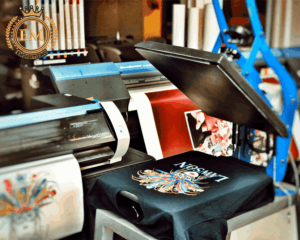
Per dare vita ai tuoi disegni, you’;LL necessita di vari materiali specifici per la stampa dello schermo:
Schermi:
Come menzionato prima, Gli schermi sono un materiale fondamentale nella stampa dello schermo. Sono disponibili in diverse dimensioni e conteggi di mesh per ospitare diverse dimensioni e livelli di dettaglio.
Inchiostri:
Gli inchiostri da stampa sullo schermo sono disponibili in varie formulazioni, come a base d'acqua, plastisol, e scarico. It’;è importante scegliere inchiostri compatibili con la superficie di stampa e l'effetto desiderato.
Emulsione:
L'emulsione è un liquido sensibile alla luce che ricopre lo schermo e consente di creare aperture di stencil per l'inchiostro. Esistono diversi tipi di emulsione, tra cui dual-cure e diazo, ciascuno con i propri requisiti di esposizione e sviluppo.
Prodotti per la pulizia:
La pulizia e la manutenzione adeguate degli schermi sono essenziali per ottenere risultati coerenti. Prodotti chimici per la pulizia dello schermo, Emulsion Removers, and scrub brushes are a few examples of the cleaning supplies you’;avrò bisogno.
Substrati:
Substrates are the surfaces onto which you’;stamperò. Questi possono includere magliette, manifesti, carta, legna, metallo, e altro ancora. Ensure that the substrates you choose are suitable for the ink type you’;Rieducono e può resistere al processo di indurimento.
Setup e tecniche di stampa dello schermo:
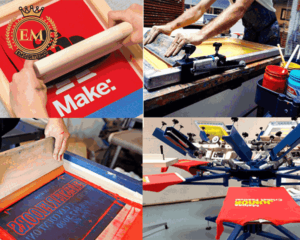
Per ottenere i migliori risultati nella stampa dello schermo, it’;è fondamentale per impostare correttamente l'area di lavoro e impiegare tecniche efficaci:
Preparazione del design:
Prima di poter creare uno schermo, you’;Avrà bisogno di un design adeguatamente preparato. Ciò comporta la conversione delle tue opere d'arte in un contrasto alto, Immagine in bianco e nero e prepararla per l'esposizione allo schermo.
Preparazione dello schermo:
La preparazione corretta dello schermo è essenziale per raggiungere stampe pulite e accurate. Ciò include il rivestimento dello schermo con emulsione, Garantire una copertura uniforme e costante, e asciugare correttamente e conservare gli schermi per evitare un'esposizione prematura.
Registrazione:
La registrazione si riferisce all'allineamento di più schermi per garantire che ogni colore in un design si allineino correttamente. Tecniche come l'utilizzo dei marchi di registrazione e i morsetti delle cerniere possono aiutarti a ottenere una registrazione precisa.
Tecniche di stampa:
Diverse tecniche di stampa, come le indicatori di alluvione, Colori spot, e mezzitoni, può aggiungere profondità, struttura, e interesse visivo per le tue stampe. Sperimentare con queste tecniche può aiutarti a ottenere effetti unici ed elevare i tuoi progetti.
Suggerimenti per principianti e risoluzione dei problemi:
Per i principianti che si avventurano nella stampa dello schermo, Ecco alcuni consigli utili da tenere a mente:
- A partire da semplici design ti aiuterà a cogliere le tecniche di base e ad acquisire fiducia prima di passare a progetti più complessi.
- Imparare a controllare il flusso di inchiostro, pressione della spatola, e la velocità dell'ictus ti aiuterà a ottenere stampe coerenti e persino.
- La pulizia e la manutenzione regolarmente della tua attrezzatura prolungheranno la sua durata e garantirà prestazioni ottimali.
- La stampa dello schermo viene fornita con la sua giusta dose di sfide. Imparare a identificare e risolvere problemi come sanguinamento dell'inchiostro, fantasma, o una registrazione impropria ti aiuterà a superare gli ostacoli e migliorare le tue stampe.
Conclusione:
Insomma, La stampa sullo schermo nell'arte è una forma dinamica e gratificante di stampa che ti consente di scatenare la tua creatività e produrre design visivamente sbalorditivi. Comprendendo le varie forniture per lo schermo di seta, Attrezzatura da stampa a schermo, e accessori necessari, nonché configurazione e tecniche adeguate, Puoi intraprendere un viaggio di stampa sullo schermo di successo. Ricordati di sperimentare, Impara dalle tue esperienze, e perfezionano continuamente il tuo mestiere. Stampa felice!
Se desideri personalizzare la digitalizzazione del logo del ricamo, DIGITALIZZAZIONE EM sarà la tua scelta migliore. Presso EM DIGITALIZZAZIONE, forniamo il miglior logo da ricamo servizi di digitalizzazione con la migliore qualità. Noi offriamo 50% di sconto su tutti i nostri servizi ai nostri potenziali clienti al loro primo ordine. Così, richiedi subito un preventivo gratuito e ci metteremo in contatto con te.
Spero che questo articolo sia utile per voi ragazzi!
Se ci sono domande relative a questo articolo, non esitare a commentarci. E, grazie per aver letto!
Gli strumenti utilizzati nella stampa dello schermo includono uno schermo (fatto di mesh), uno spremuto, inchiostro, una stampa o una cornice, e materiali di stencil (come emulsione o film).
Per creare una stampa a schermo, Avrai bisogno di un design o di un'immagine, uno schermo trasparente o rivestito di emulsione, una fonte luminosa per l'esposizione, una cabina o un lavandino per risciacquare, e attrezzatura di asciugatura.
I migliori materiali per la stampa a schermo sono in genere tessuti di cotone o miscela di cotone, Mentre assorbono e tengono bene l'inchiostro. Tuttavia, Altri materiali come il poliestere o il nylon possono anche essere utilizzati con inchiostri e additivi appropriati.
Per avviare un'attività di stampa a maglietta, Avrai bisogno di una stampa o una giostra, Un'unità di asciugatura o asciugatrice, Un'unità di esposizione o un tavolo luminoso, una cabina o un lavandino, schermi, racle, inchiostri, una pressa a caldo (facoltativo per curare), e un computer con disegno Software.
